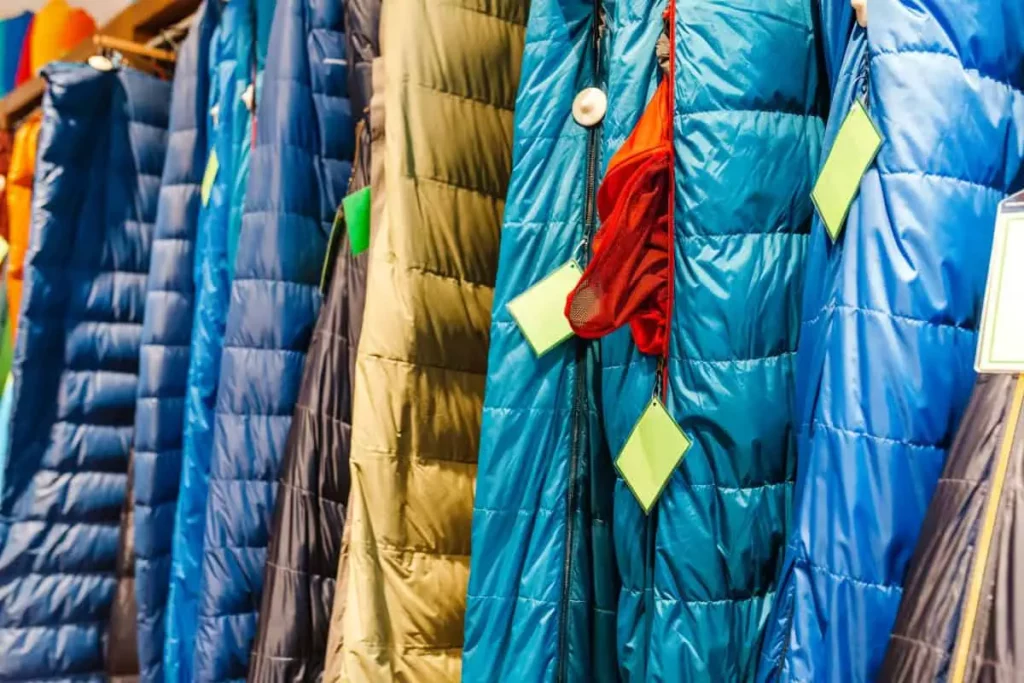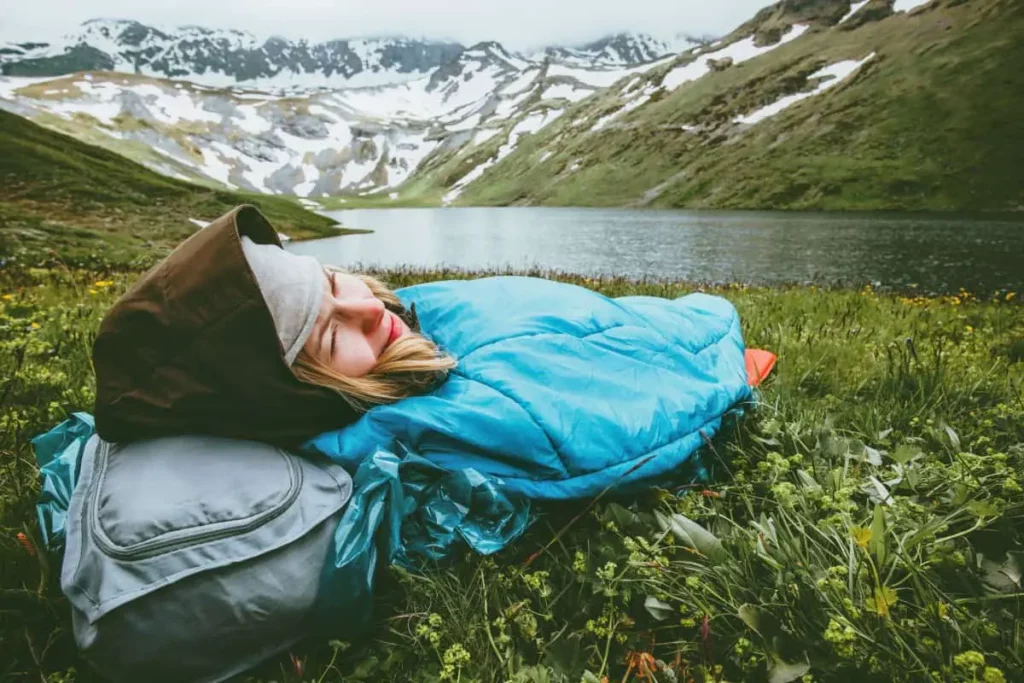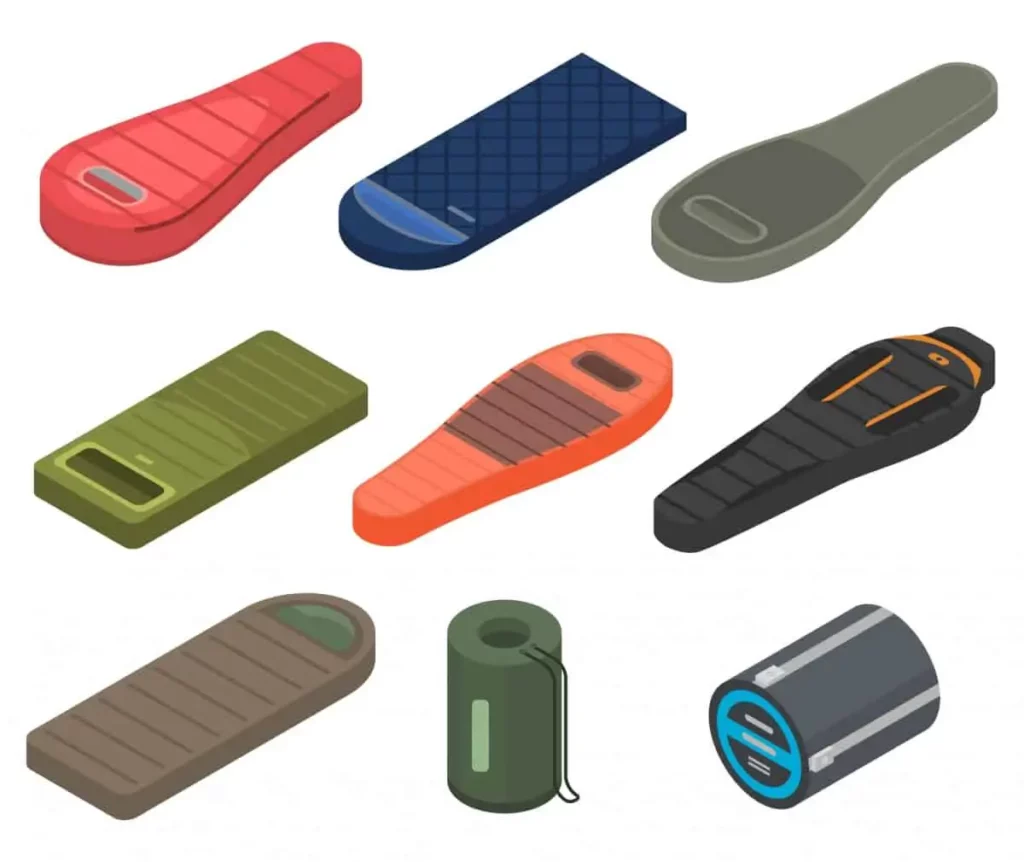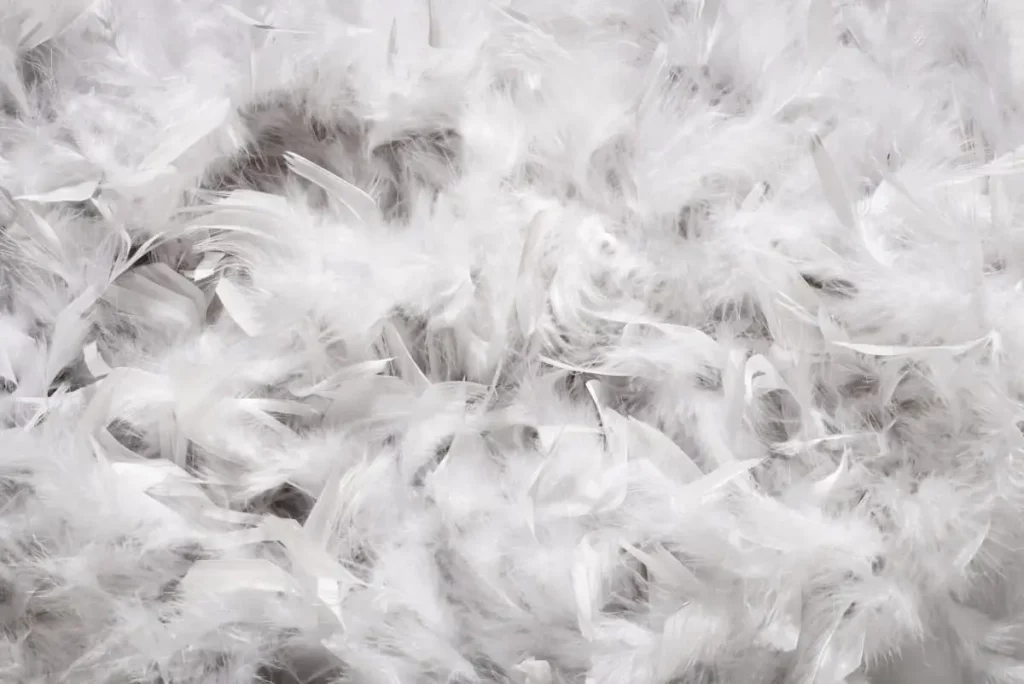This post contains affiliate links.
Sleeping bags come in many different styles, shapes and sizes and are rated to be most comfortable in a specific temperature range. Matching the proper sleeping bag temperature rating to the season and condition you plan to camp in will ensure you don’t get too warm or too cold while camping.
Sleeping bag ratings provide an indication of the lowest temperature that the bag’s insulation will withstand before you’ll get cold inside. If you’re using a winter mummy bag for summer camping you will find it too warm for sleeping. The use of a summer bag or just a sleeping bag liner in the warmer months of the year will help you stay cooler and get a more comfortable sleep.
In this article we’ll cover how the temperature rating of your sleeping bag is determined, how it changes with common sleeping bag designs, the materials used to make them, and how to choose the best one for your camping needs.

Table of Contents
What is a Sleeping Bag Temperature Rating?
You’ve probably seen the temperature ratings on the tags and descriptions of sleeping bags before, but what do they actually mean? To understand that question, you have to understand how they come up with the temperature ratings to begin with.
Back before 2010, every independent sleeping bag manufacturer tested their own bags to come up with their own ratings. Some companies would have their test subjects sleep in flannel pajamas, while some would have them sleep in just underwear. Some would control for humidity, some wouldn’t, etc.
The result was that in the US you could have two 25 degree rated bags that performed very differently in those conditions based on how the manufacturers tested them.
Testing Standards For Sleeping Bags
To fix that, the US adopted the EN (European Norm) standards of testing in 2010. This standardized means of testing ensured that each sleeping bag rated for a specific temperature performed the same as the others.
The EN has since been replaced by the ISO (International Standards Organization) for sleeping bag testing, however they use almost the same testing conditions and standards so you can still compare one to the other.
What is a Comfort Rating and Lower Limit Rating
Whether your sleeping bag is EN or ISO tested, it will generally have two ratings: the comfort rating and the lower limit rating. The two ratings came about because women get colder than men when they sleep, so the comfort rating represents the lowest temperature that a woman (or cold sleeper) can sleep in the bag and not get cold, but is still comfortable for men (or warm sleepers).
The lower limit, on the other hand, is the coldest outside temperature that a man (or warm sleeper) will stay warm sleeping in. The temperature range between the lower limit and the comfort values is usually between 10-20 degrees.
If it gets below the lower limit temperature while you’re camping you’ll need to layer up or add other insulation like a sleeping bag liner. If it gets above the comfort temperature, then it’s likely your sleeping bag will be too warm.

A Tip about Ratings
As with everything, the ratings are best taken as estimates instead of exact temperatures. Humidity, windchill, camping surface, and other conditions will all factor into how well your sleeping bag handles the cold.
One last thing to keep in mind is that the temperature ratings are made with the assumption that you are using a sleeping pad, so if you aren’t planning to bring one your 20 degree lower-limit-rated bag may actually be more like 30.
Types of Sleeping Bags
Sleeping bags come in all shapes, sizes, and thicknesses, and the temperature rating isn’t the only thing that will give you an idea of how they’ll hold up. You can look at the specific type of seasonality and shape for more information.
3 Season vs 4 Season Sleeping Bags
Some sleeping bags will be designated as summer, 3 season, 4 season, or expeditionary in addition to or even instead of the temperature rating. This gives you an idea of the conditions it can withstand before you even look at the temperature rating.
Sleeping Bags For Summer
Summer sleeping bags are generally recommended for temperatures above freezing or 32 degrees and up. They’re usually rectangular in shape and thinly insulated compared to the other sleeping bag styles. These sleeping bags, like their name implies, are best-suited for warmer camping seasons.

- 600 Fill DriDown Insulation
- Lightweight, compressible and comfortable
- Rated down to 30F
- Cinch cord to help you stay cozy
- Anti-snag zipper
- Includes stuff sack
Sleeping Bags For Spring and Fall
3 season sleeping bags, on the other hand, are rated for colder temperatures. These sleeping bags can usually handle down to 15-20 degrees and have thicker insulation than the summer bags. While you can expect to stay warm in these bags in lower temperatures, you can also expect to get too warm in them much faster.
Winter Sleeping Bags
4 season sleeping bags, also called winter sleeping bags, are able to handle even colder temperatures. These bags are for the true winter campers – able to handle temperatures lower than 20 degrees. They are even more insulated than 3 season sleeping bags, and are also less forgiving in warmer weather.
The main difference between 3 season and 4 season sleeping bags is the amount of insulation used. The fill power of the bag is a measure of how much insulation is packed in, and while 3 season bags will usually have a fill rating of 600+, 4 season bags tend to be 900+.

- Blanket Fold draft collar for warmth
- Relaxed Spoon shape for side sleeping
- Moisture resistant Stratofiber insulation
- Zippered stash pocket for electronics
- Men’s and Women’s bags zipper together
- Anti-snag zipper
- Lifetime warranty
Expedition Sleeping Bags
The last kind of sleeping bag is for the hardcore adventurers who go regularly into subzero temperatures. The expeditionary bags can be rated for temperatures as low as -40 degrees, and as I’m sure you can imagine these would be the easiest bags to get too warm in.
For more ways to beat the cold on your next camping trip check out our post on How To Stay Warm in a Tent

Sleeping Bag Shapes
Just like the seasonality will give you an idea of the temperature range, the shape of the bag will as well. Rectangle sleeping bags are the least warm. They allow you plenty of room to turn over in, and this extra space is why they don’t tend to keep you as warm.
Mummy Bags
Mummy bags, on the other hand, are the warmest bag shape. Like the name implies, these wrap you up like a mummy in a form-fitting bag. They usually have hoods built in, and instead of rolling over inside the bag you actually have to roll over with the whole bag.
Barrel Bags
A compromise between the rectangle bags and the mummy bags are the barrel or modified mummy bags. These sleeping bags are roomier than a mummy bag but warmer than a rectangle bag. Many 3 season bags have this shape, while almost all 4 season bags are true mummies.
Quilts
One last shape that has become more popular recently is the quilt. These sleeping bags are generally barrel or mummy style, but with no insulation on the bottom of the bag. Instead, all of the insulation is piled on top like a large quilt. One thing to consider is that these bags don’t usually have a hood which makes them less warm than those that do.
What Are Sleeping Bags Filled With?
Sleeping bags today are filled with either down feathers for insulation or a synthetic fiber blend. Each has their own advantages and disadvantages, and the amount and type of insulation will depend on the type of sleeping bag you have.
Synthetic Insulation
Synthetic insulation is great for two main reasons: it’s cheap, and it works even when it gets wet. Price is always something to consider and synthetic insulation is a great economic option. It also works well in damp situations, and depending where you’re planning on camping that can be a huge help.
The main downside to synthetic insulation is that it isn’t as warm as down. This makes it a viable option for summer and even 3 season sleeping bags, but for any colder camping you may want to go with down. It’s also worth noting that synthetic insulation is heavier, and may be less desirable for backpackers.

Down Insulation
A down filled sleeping bag has many big advantages. To start, down is extremely lightweight and packs down to a smaller space than synthetic insulation. It’s also warmer than synthetic blends and needs less fill to accomplish the same level of warmth.
On the other hand, down is much more expensive than synthetic insulation. It also takes a lot longer to dry once it gets wet, which can be a problem if you’re camping in damp conditions. You also have to make sure you store down properly and don’t leave it compressed for too long, otherwise it’ll lose its loft or the ability to expand after storage. If a sleeping bag loses loft, it loses warmth.
Overall, down is worth the investment if you are planning to do a lot of cold weather camping. It’s ideal for backpacking due to its lightweight nature, and as long as you take care to store it properly and keep it dry it will last.
How Warm Of A Sleeping Bag Should I Buy?
The first thing you need to determine is what temperatures you are wanting to camp in. This will require some research and planning, and then you’re going to want to compare temperature ratings.
Make sure the bag you choose has a minimum rating that will fit your camping style, and keep in mind the differences in insulation. You’ll also want to give yourself a 10 degree buffer just in case the temperature dips lower than expected.
One thing you can do to give your sleeping bag an extra warmth boost is to invest in a liner. Combined with a 3 season sleeping bag, a liner can make you comfortable in well-below freezing temperatures. You can add layers of clothing as well, but knowing ahead of time what conditions you’ll be camping in will help you prepare accordingly.

- Made of lightweight and breathable Thermolite
- Adds up to 14 degrees of warmth
- Use inside sleeping bag or on its own
- Quick drying, stretchy and soft
- More packable than fleece
- Box foot and hood design
Can I Connect 2 Sleeping Bags Together?
The short answer is yes, and the longer answer is it depends. There are many reasons you may want to share a sleeping bag with a partner, and chief among them is you’ll both be warmer. There are double sleeping bags that are designed for this purpose, but if you both already have bags then you may be able to improvise one instead.
If you have two rectangular sleeping bags that are the same zipper orientation and gauge, then connecting them is easy. Where the problems start is if you don’t have rectangular bags or if the zippers don’t match. This is something you’ll want to figure out before you get to your campsite if possible, otherwise you may lose your spooning buddy to their own sleeping bag.
Closing Thoughts
You can definitely be too warm in your sleeping bag, but you can just as easily be too cold. By looking at the temperature rating, the seasonality description, the shape, and the insulation type, you can find the sleeping bag that’ll give you the best night’s sleep on your next camping trip.
